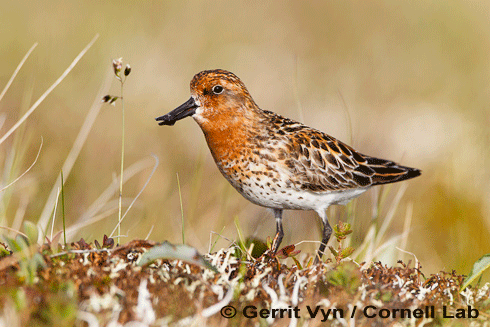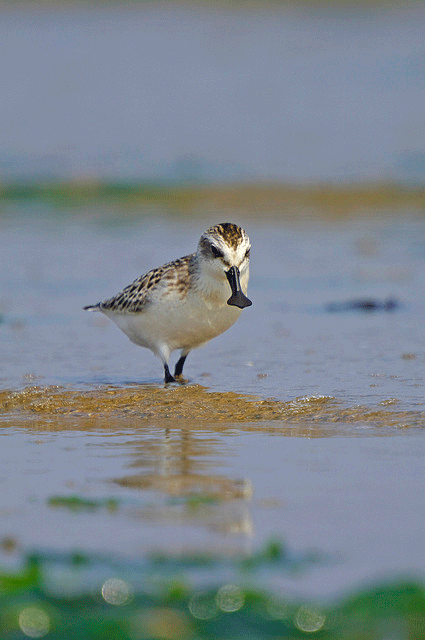BirdNote ® Spoon-billed Sandpiper
Air Date: Week of November 9, 2012

One of the rarest birds in the world migrates to the far northeast of Russia to breed each summer. Cornell Laboratory photographer Gerrit Vyn reports.
Transcript
CURWOOD: It's Living on Earth - I'm Steve Curwood.
[MUX - BIRDNOTE® THEME]
CURWOOD: Of all the threats to our natural world, humans, and our insatiable development, may be the most deadly. That's what sound recordist and photographer Gerrit Vyn of the Cornell Lab found on a visit to Russia's far north.
[SONG OF THE SPOON-BILLED SANDPIPER]
VYN: That’s the song of one of the rarest birds on earth – the Spoon-billed Sandpiper. I recorded it in the far northeast of Russia where as few as 100 remaining pairs of this mysterious little sandpiper, with a remarkable spoon-shaped beak, go to breed each summer.

The Spoon-billed Sandpiper non-breeding plumage. (Photo: © Nkenji flickr)
[RHYTHMICALLY REPEATED CALL OF SPOON-BILLED SANDPIPER]
VYN: The Spoon-billed Sandpiper depends on key coastal wetlands to fuel its long distance migration to its wintering areas. And for many species migrating south on the flyway from eastern Russia and Alaska, to Southeast Asia, Australia and New Zealand, the Yellow Sea is “Grand Central Station” for birds. They all stop there to refuel and continue their journeys.
[FLOCK CALLS OF DUNLIN]
VYN: But the Yellow Sea is not what it used to be – massive projects in China and South Korea for agriculture, aquaculture, and industry have eliminated more than half of the intertidal areas that all of these migrants depend on. And for many, their populations are rapidly falling. The Spoon-billed Sandpiper may soon be extinct.
[ADULT SPOON-BILL NEST CALLS]
VYN: I came to know a handful of these beautiful birds in the velvety hills of Siberia as they sang, courted, and eventually settled down to nest. I sat on the tundra with a Spoon-billed Sandpiper as its eggs were hatching and watched as the downy doe-eyed chicks took their first feeble steps into our rapidly changing world.
[SONG OF THE SPOON-BILLED SANDPIPER]
CURWOOD: Gerrit Vyn works as a natural history sound recordist at Cornell.
There are pictures of Endangered Spoonbills at our web-site, loe dot org.
[Vocalizations of the Spoon-billed Sandpiper provided by The Macaulay Library at the Cornell Lab of Ornithology, Ithaca, New York. Song of Spoon-billed Sandpiper [166364], Rhythmically repeated call [166371], calls of adults and chicks at nest [166378] recorded by Gerrit Vyn; flock calls of Dunlin [59435] recorded by W.W.H. Gunn.
Producer: John Kessler
Executive Producer: Chris Peterson
© 2012 Tune In to Nature.org November 2012 Narrator: Gerrit Vyn]
Living on Earth wants to hear from you!
Living on Earth
62 Calef Highway, Suite 212
Lee, NH 03861
Telephone: 617-287-4121
E-mail: comments@loe.org
Newsletter [Click here]
Donate to Living on Earth!
Living on Earth is an independent media program and relies entirely on contributions from listeners and institutions supporting public service. Please donate now to preserve an independent environmental voice.
NewsletterLiving on Earth offers a weekly delivery of the show's rundown to your mailbox. Sign up for our newsletter today!
 Sailors For The Sea: Be the change you want to sea.
Sailors For The Sea: Be the change you want to sea.
 The Grantham Foundation for the Protection of the Environment: Committed to protecting and improving the health of the global environment.
The Grantham Foundation for the Protection of the Environment: Committed to protecting and improving the health of the global environment.
 Contribute to Living on Earth and receive, as our gift to you, an archival print of one of Mark Seth Lender's extraordinary wildlife photographs. Follow the link to see Mark's current collection of photographs.
Contribute to Living on Earth and receive, as our gift to you, an archival print of one of Mark Seth Lender's extraordinary wildlife photographs. Follow the link to see Mark's current collection of photographs.
 Buy a signed copy of Mark Seth Lender's book Smeagull the Seagull & support Living on Earth
Buy a signed copy of Mark Seth Lender's book Smeagull the Seagull & support Living on Earth

